Fake Accounts, Real Problems

Or, the hidden value of the internet’s ugly ducklings—and where to find them
Meta (née Facebook) deletes an average 1.5 billion fraudulent accounts each quarter.[1] Somewhere between 5 and 30% of Twitter accounts are fake, and that number rises even higher for prominent figures, especially politicians.[2] In 2018, 43.8% of @HillaryClinton’s followers were bots, spam, inactive, or purveyors of blatant propaganda. And not to be outdone, @realDonaldTrump’s number was 61%.[3]
It isn’t hard to understand why there are so many fake accounts. It’s laughably easy to make one. Just create an email address, submit it to Twitter, enter in whatever demographic information suits your fancy, and presto! Now you’re a 50-something Nebraska housewife with a conservative voting record and a husband who’s considering joining the union drive at the chicken plant. And you’re posting in Mike Pence’s replies.
This is even before considering that real, flesh-and-blood social media users may not always present themselves honestly. The phenomenon is common enough to have earned a name: the “false Facebook self.”[4]
Much has been written about the bad effects of fake accounts on American political life. Rightly so. A digital army of 50,000+ Russian bots may have helped swing the 2016 election to @realDonaldTrump.[5]
But fake accounts are also a problem for executives, journalists, politicians—anyone who hopes to use online data to make good strategic decisions or understand the American public. In 2021 digital ad spending rose 35% to $189 billion.[6] Who exactly was this reaching? And to what effect? Were social media-scraping political campaigns really learning about the preferences of Nebraska housewives—or being duped? Given the prevalence of fake accounts, it’s no wonder that it’s hard to advertise effectively online.
It’s time to consider that the low barrier to entry for social media may make it inherently unreliable as a source of data. It’s just too easy to fake. Maybe people keep advertising and conducting research online because it just seems like the only option.
At Filterlabs.ai, we think there are other, better ways.
Consider the ugly ducklings of the internet: hand-made websites. From clubs and small businesses to churches and not-for-profits, institutions and people still build their own private web pages all the time. They’re not always pretty to look at. The design aesthetic is either out of a WordPress template box or reminiscent of the early 90’s (think Geocities). They’re clunky to use and, frankly, made with more time and love than skill.
But that might be what makes them valuable. The amount of effort that goes into making even one personal website is tremendous. It just wouldn’t be practical to make a million fake pages. As a result, the information we get from these ugly duckling websites may actually be more reliable than what we can glean from social media feeds.
This is why our technology targets hard to find websites rather than potentially distorted social media feeds.
Tracking Polarization
At FilterLabs we've been tracking polarization in Russia since the war began. Throughout the month of March there was high polarization around the war, but it is now beginning to settle down in some places. We think this suggests that state propaganda is starting to have an effect.

For more analysis, check out www.filter-russia.com
[1] Statistica Research Department. “Global number of fake accounts taken action on by Facebook from 4th quarter 2017 to 4th quarter 2021.” Statistica, March 8, 2022. Accessed April 20, 2022. https://www.statista.com/statistics/1013474/facebook-fake-account-removal-quarter/#:~:text=In%20the%20fourth%20quarter%20of,by%20the%20social%20media%20platform.
[2] “The Problem with Follower Count.” SparkToro. April 20, 2022. https://sparktoro.com/tools/fake-followers-audit.
[3] Fishkin, Rand. “We Analyzed Every Twitter Account Following Donald Trump: 61% Are Bots, Span, Inactive, or Propaganda.” SparkToro. October 9, 2018.
[4] Gil-Or, Oren et al. “The ‘Facebook-self’: characteristics and psychological predictors of false self-presentation on Facebook.” Frontiers in Psychology. Vol. 6 99. February 17, 2015.
[5] Jon Swaine. “Twitter admits far more Russian bots posted on election than it had disclosed.” The Guardian. January 19, 2018. Accessed April 20, 2022. https://www.theguardian.com/technology/2018/jan/19/twitter-admits-far-more-russian-bots-posted-on-election-than-it-had-disclosed. See also Jane Meyer. “How Russia Helped to Swing the Election for Trump.” The New Yorker. October 1, 2018. Accessed April 20, 2022. https://www.newyorker.com/magazine/2018/10/01/how-russia-helped-to-swing-the-election-for-trump
[6] “Digital Advertising Soared 35% to $189 Billion in 2021 According to the IAB Internet Advertising Revenue Report.” Iab. April 12, 2022. Accessed April 20, 2022. https://www.iab.com/news/digital-advertising-soared-35-to-189-billion-in-2021-according-to-the-iab-internet-advertising-revenue-report/.
